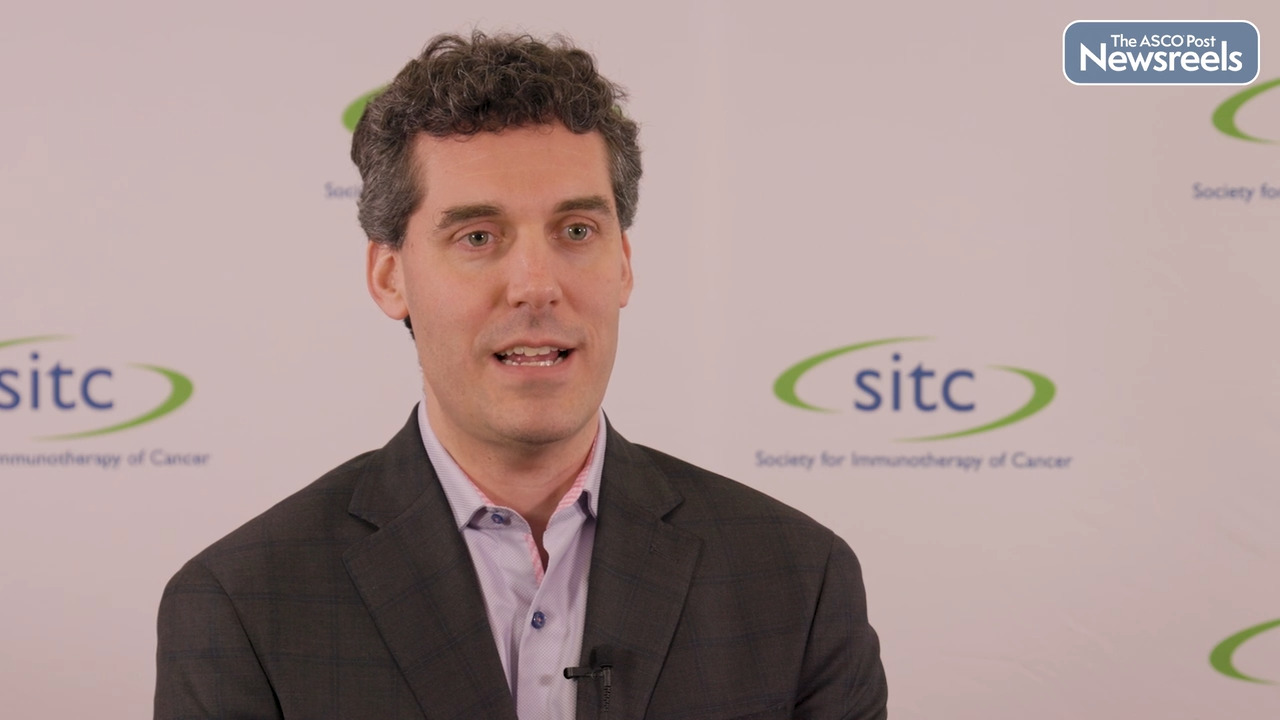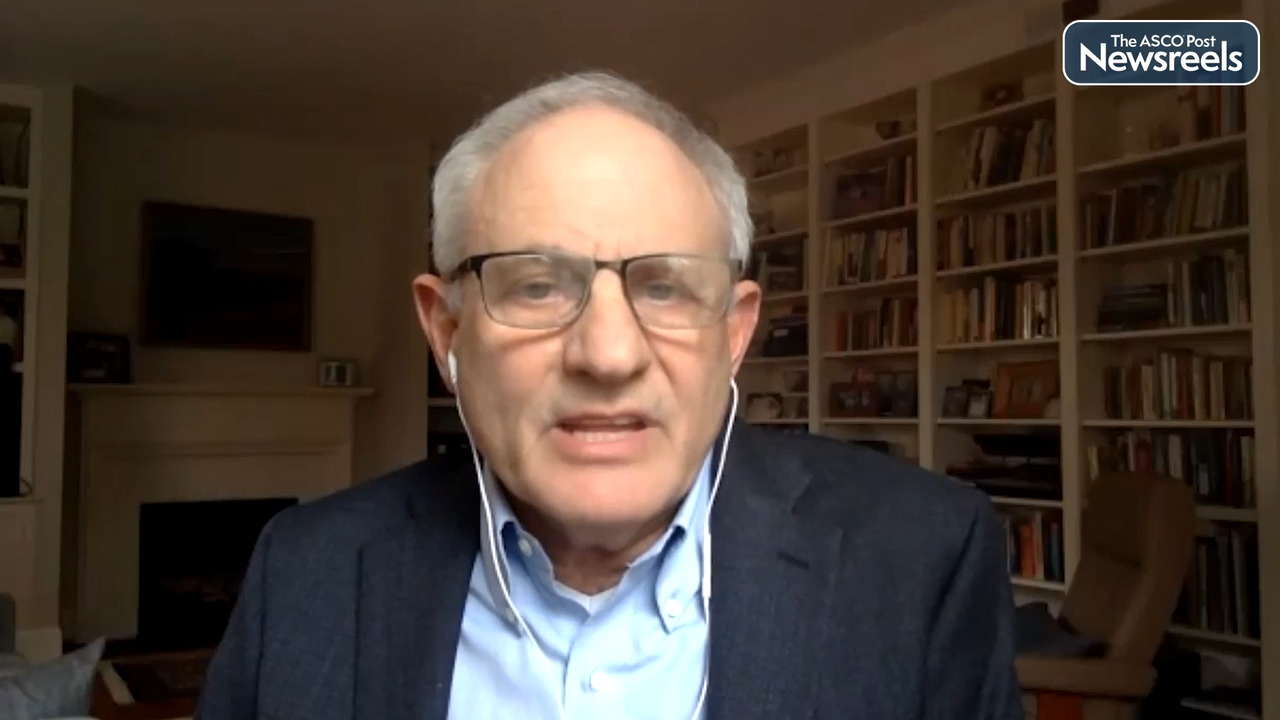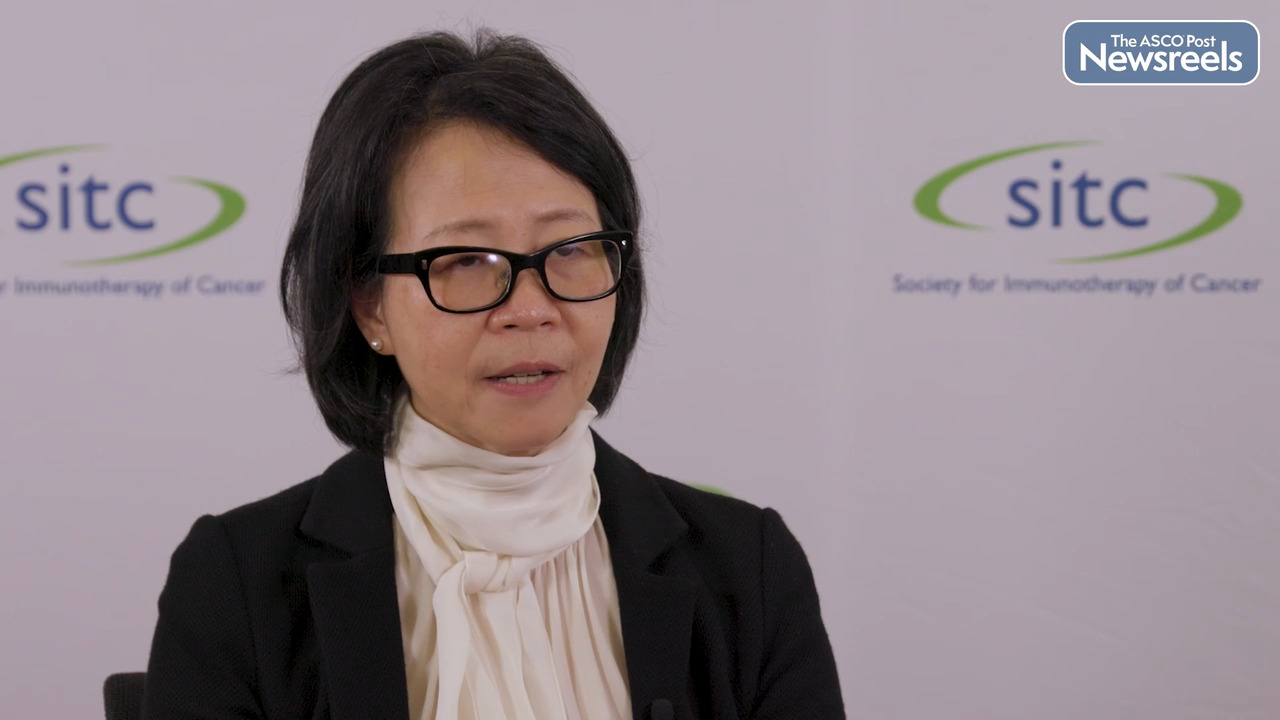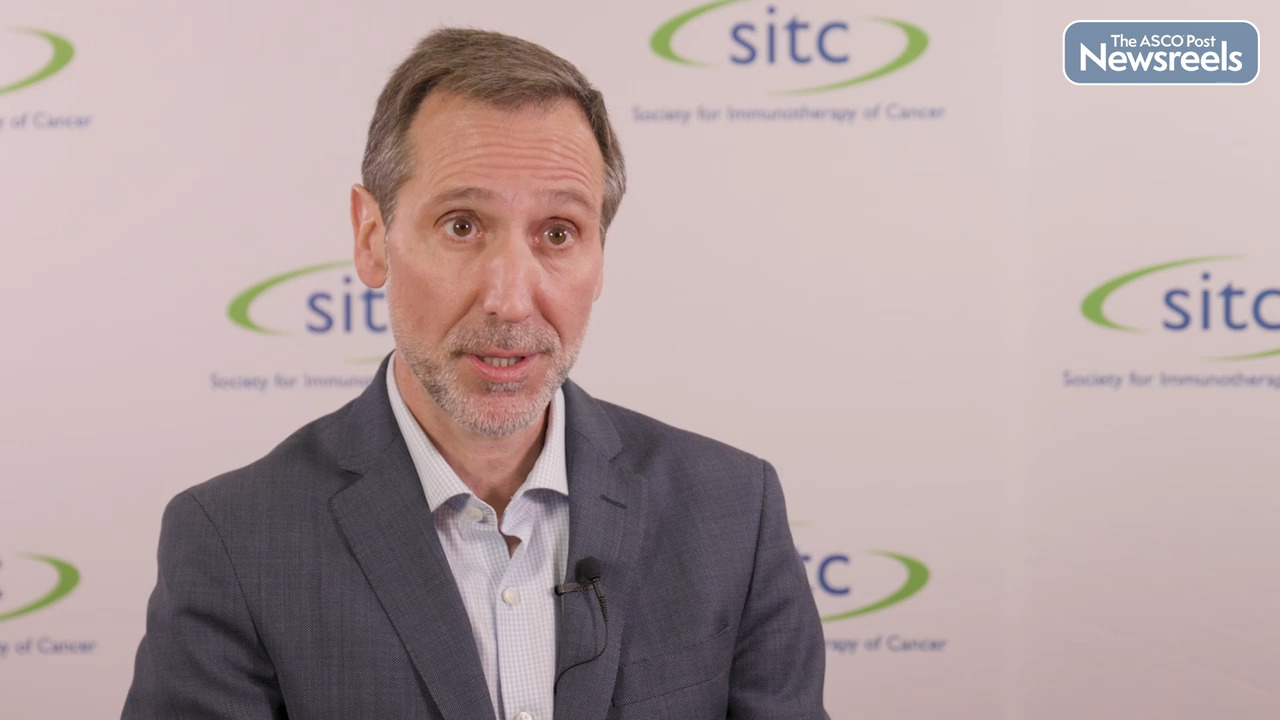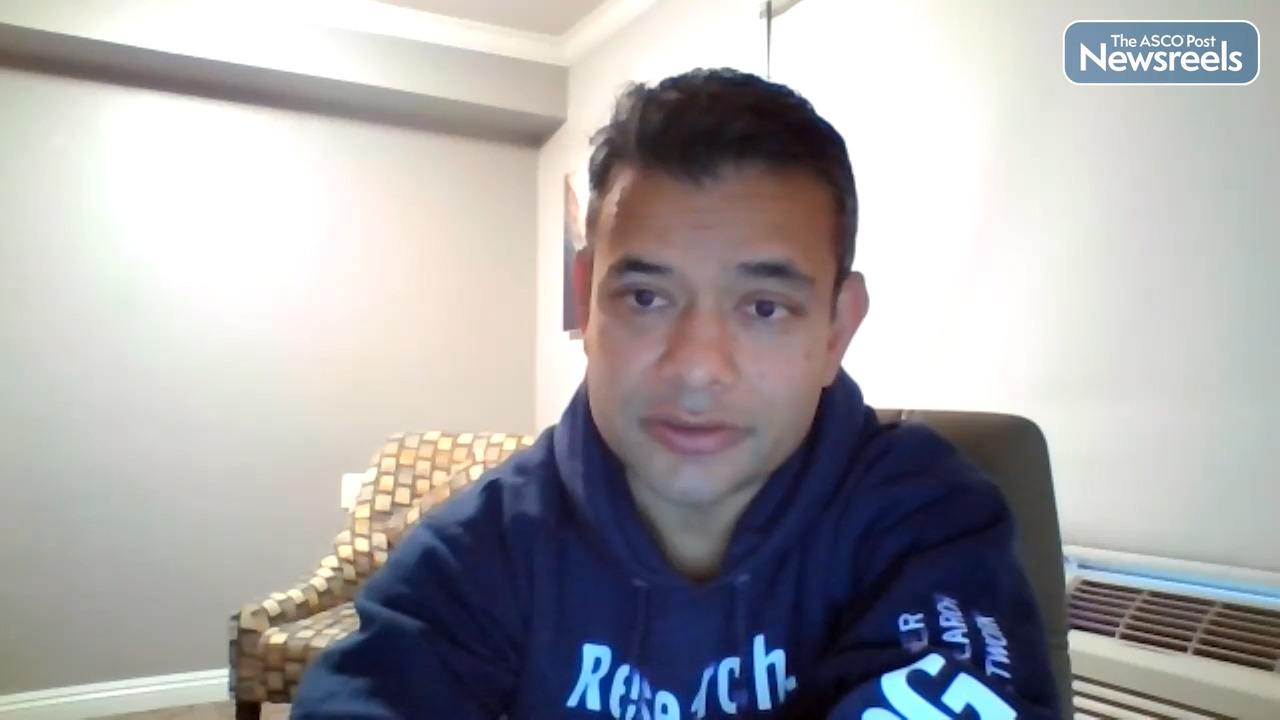Wade T. Iams, MD, on NSCLC: Combining an Antigen-Presenting Cell Activator With Pembrolizumab
SITC 2022
Wade T. Iams, MD, of Vanderbilt University Medical Center, discusses phase II efficacy results from the first-line non–small cell lung cancer cohort of the TACTI-002 study. The results suggest that when combined with pembrolizumab, eftilagimod alpha yielded encouraging efficacy across all PD-L1 levels, including patients with PD-L1 low and PD-L1 negative disease (Abstract 1470).
Transcript
Disclaimer: This video transcript has not been proofread or edited and may contain errors.
The purpose of this study was to evaluate the soluble LAG-3 agonist, FD, in combination with pembrolizumab in patients with non-small cell lung cancer who were treatment naive. This is the first-line cohort of the -D002 clinical trial, and the approach was FD plus pembrolizumab for one year followed by pembrolizumab continuation for a second year for patients who continued to achieve clinical benefit. Key components of the clinical trial cohort. It was 114 patients. PDL1 was evenly spaced from less than 1%, 1% to 49%, and greater than 50%. In fact, 75% of patients had PDL1 less than 50%. Histology included squamous in one-third of patients and non-squamous in two-thirds of patients. The primary endpoint was objective response rate with a benchmark of 35% set to compare historically in this single arm study. The primary endpoint was met with an objective response rate of 40%.
Across histologies, we saw this even between squamous and non-squamous, and we did see step-wise benefit in response by PDL1 status. So patients with PDL1 less than 1% had an objective response rate of 30%, which is impressive for this often difficult to treat cohort without chemotherapy, patients with PDL1 1% to 49% had a response rate of 45%, and patients with PDL1 greater than 50% had a response rate of 55%.
The survival outcomes are still maturing, but we do have a median duration of response among responders that's an interim value to report, and that's 22 months. So very good duration of response in patients who did respond from this therapy. We did see step-wise improvement in median progression-free survival in addition to response by PDL1 status. So patients with PDL1 high disease had the longest median progression-free survival and step-wise decrease by lower PDL1 when individuals were treated with the FD plus pembrolizumab combination. We await longer-term results for the survival outcomes.
In terms of toxicity, the combination of FD plus pembrolizumab was highly tolerable, more similar to pembrolizumab monotherapy, when we focus in on unique toxicities; that includes injection site reaction. Because FD is a subcutaneous injection, the frequency of injection site reaction was approximately 25% in these patients. It was grade one and two in all patients. There were no grade three or greater injection site reactions. And honing in to immune-related adverse events and whether that combination of FD plus pembrolizumab adds to toxicity, we did not see increases compared to typical numbers for clinical trials in patients with treatment naive non-small cell lung cancer. Rates of pneumonitis were approximately 5%. Thyroid abnormalities were also around 5% for immune-related adverse events in this patient population.
In sum, and a critical point of emphasis, FD is a soluble LAG-3 agonist, which has a distinct mechanism of action compared to our currently available LAG-3 monoclonal antibodies. It activates antigen presenting cells upstream of T cells and, in combination with pembrolizumab in this moderate size cohort of treatment naive patients with non-small cell lung cancer, we saw very encouraging objective response results and encouraging survival results that are still maturing. So ongoing discussions with regulatory agencies continue and we look forward to further development of FD.
The ASCO Post Staff
Michael A. Postow, MD, of Memorial Sloan Kettering Cancer Center, discusses new findings on the correlation between CD8 cell PET imaging with zirconium-89–crefmirlimab berdoxam and CD8 cell immunohistochemistry in patients with advanced cancer receiving immunotherapy. Noninvasive CD8 PET scanning with crefmirlimab berdoxam permits whole-patient, longitudinal CD8 assessment, which is currently under investigation as a biomarker for immunotherapy responsiveness and may be a useful tool for immunotherapy development and clinical management (Abstract 1472).
The ASCO Post Staff
Michael B. Atkins, MD, of Georgetown Lombardi Comprehensive Cancer Center, explores recent clinical trials in immuno-oncology in which the phase III trial produced markedly different results from the phase II trial. To help understand the potential value to patients of late-stage trials of treatment combinations, the Society for Immunotherapy of Cancer has developed a checklist for investigators, applicable to any regimen in which immune modulation is an important component of the antitumor effect.
The ASCO Post Staff
Julia Tchou, MD, PhD, of the University of Pennsylvania, discusses preliminary results of the phase Ib/II BreastVax study, which suggested a single preoperative pembrolizumab dose plus a tumor-targeting radiation boost may result in pathologic response in patients with early-stage triple-negative breast cancer (Abstract 644).
The ASCO Post Staff
Antoni Ribas, MD, PhD, of the University of California, Los Angeles, discusses a phase I study that used CRISPR gene editing to simultaneously “knock out” endogenous T-cell receptors and replace them with personalized neoantigen T-cell receptors in patients with solid tumors. The edited TCR T-cell products were safely infused and trafficked to the tumor lesions (Abstract 1478).
The ASCO Post Staff
Sumanta Pal, MD, of the City of Hope Comprehensive Cancer Center, discusses phase I results from the COBALT-RCC study, a first-in-human clinical trial exploring CD70 CAR T-cell therapy in patients with clear cell renal cell carcinoma. The agent appeared to show an excellent safety profile with no unexpected toxicities and antitumor activity. One durable complete response is the first to be achieved with allogeneic CAR T-cell therapy in patients with relapsed or refractory solid tumors, offering proof of concept for further exploration of CD70-targeted CAR T cells in renal cell and other CD70-positive malignancies (Abstract 558).
